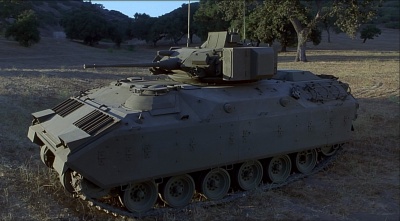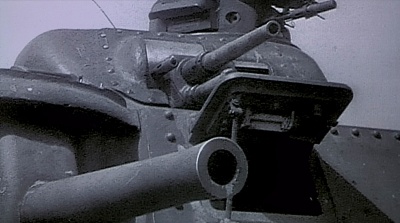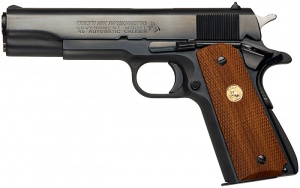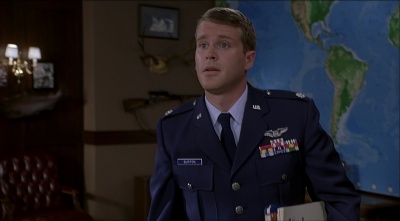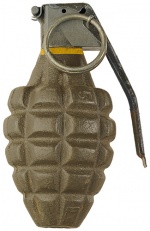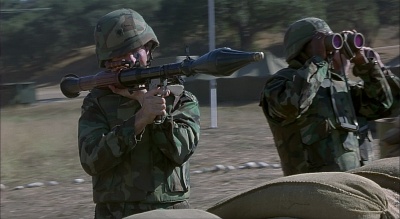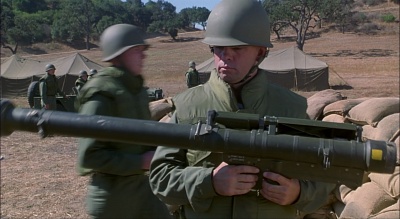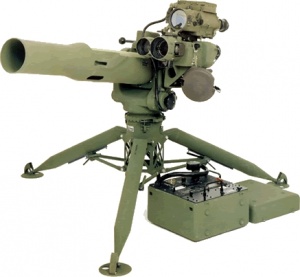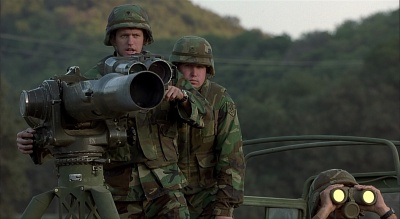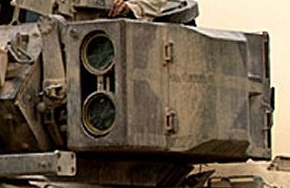| If you have been locked out of your account you can request a password reset here. |
Difference between revisions of "The Pentagon Wars"
| Line 56: | Line 56: | ||
==FIM-43 Redeye== | ==FIM-43 Redeye== | ||
| − | The [[FIM-43 Redeye]] anti-aircraft missile appears in the film, mocked up as an experimental heat-seeking anti-armor weapon. This | + | The [[FIM-43 Redeye]] anti-aircraft missile appears in the film, mocked up as an experimental heat-seeking anti-armor weapon. This and the sequence that follows of a Paveway bomb being "tested" by being dropped from a two-storey crane are actually both the same story, and actually about the Air Force's CBU-97 Sensor Fuzed Munition, a type of cluster bomb using self-forging submunitions which identified their targets via IR, that was under development from 1979 to 1992. In Burton's book, he claims the testing of this weapon was conducted with the bomb being dropped from a crane onto a circle of 14 tanks parked nose-to-tail, with the submunitions' IR sensors locking on to a hotplate the program supervisor had placed on top of each vehicle rather than the vehicle's engine. |
The need to make such ridiculous alterations to the target for contemporary IR seekers to sort it from ground clutter is probably the reason the TOW program went with SACLOS guidance that only had to locate an unnaturally intense IR beacon on the missile's tail. Self-guided IR-seeking anti-tank missiles would not be practical until the development of more advanced imaging infrared sensor based detectors. | The need to make such ridiculous alterations to the target for contemporary IR seekers to sort it from ground clutter is probably the reason the TOW program went with SACLOS guidance that only had to locate an unnaturally intense IR beacon on the missile's tail. Self-guided IR-seeking anti-tank missiles would not be practical until the development of more advanced imaging infrared sensor based detectors. | ||
Revision as of 10:40, 8 September 2017
The Pentagon Wars is a 1998 comedy film from HBO, directed by Richard Benjamin and starring Kelsey Grammer and Cary Elwes. It is a loose adaptation of the book The Pentagon Wars: Reformers Challenge the Old Guard by retired USAF Colonel James G. Burton with many points exaggerated for comedic effect or the result of artistic license. The film centres on the bureaucracy surrounding the troubled 17-year development of the Bradley Fighting Vehicle and the efforts of Lt. Col. James G. Burton (Elwes) to conduct a live-fire test on the vehicle with a full load of fuel and ammunition.
The following weapons appear in the film The Pentagon Wars:
M242 Bushmaster Chaingun
The M242 Bushmaster chaingun appears in the film as the primary armament of the M2 Bradley infantry fighting vehicle prototype. M242s are also seen on a line of Bradleys supposedly being produced for Israeli use with "safer" features, an outright fabrication on the movie's part since Israel only purchased a single, standard configuration vehicle for testing.
Browning M1919A4 Machine Gun
At the start of the film, archival footage showing testing of various armored vehicles is seen, including an M3 Lee medium tank with early model Browning M1919A4 machine guns mounted coaxially next to the main turret armament and in the cupola turret.
Hotchkiss M1914 Machine Gun
During the opening credits montage, a French-built Renault FT-17 light tank can be seen climbing a terrain obstacle, the vehicle armed with a Hotchkiss M1914 machine gun as the primary weapon.
Colt MK IV Series 70
U.S. military guards can be seen throughout the film carrying holstered Colt MK IV Series 70 pistols (identifiable by the Colt logos on the grips) as their sidearms, likely standing in for military-issue M1911A1 pistols.
Winchester Model 70
When Lt. Col. James G. Burton (Cary Elwes) meets the fictional Maj. General Partridge (Kelsey Grammer) at the Pentagon, a scoped Winchester Model 70 rifle can be seen mounted on the wall of General Partridge's office along with various trophies and other memorabilia.
Mk 2 Hand Grenade
During the meeting between Burton and Partridge, a Mk 2 hand grenade can be seen on Partridge's desk, likely either a replica or one that has been rendered inert.
Type 69 RPG
During live-fire testing on the Bradley, one of the weapons tested on the vehicle is a Type 69 RPG, the weapon failing to penetrate the Bradley's armor, but this is discovered to be due to the use of inferior Romanian rockets, as opposed to higher-grade Soviet rockets.
FIM-43 Redeye
The FIM-43 Redeye anti-aircraft missile appears in the film, mocked up as an experimental heat-seeking anti-armor weapon. This and the sequence that follows of a Paveway bomb being "tested" by being dropped from a two-storey crane are actually both the same story, and actually about the Air Force's CBU-97 Sensor Fuzed Munition, a type of cluster bomb using self-forging submunitions which identified their targets via IR, that was under development from 1979 to 1992. In Burton's book, he claims the testing of this weapon was conducted with the bomb being dropped from a crane onto a circle of 14 tanks parked nose-to-tail, with the submunitions' IR sensors locking on to a hotplate the program supervisor had placed on top of each vehicle rather than the vehicle's engine.
The need to make such ridiculous alterations to the target for contemporary IR seekers to sort it from ground clutter is probably the reason the TOW program went with SACLOS guidance that only had to locate an unnaturally intense IR beacon on the missile's tail. Self-guided IR-seeking anti-tank missiles would not be practical until the development of more advanced imaging infrared sensor based detectors.
M16A1 Rifle
The evening prior to the final live-fire test on the Bradley at the end of the film, Lt. Col. Burton visits the barracks of the soldiers charged with prepping the Bradley for the test and tells them a story about a soldier he encountered who was wounded in action in Vietnam after having his M16 rifle jam on him in combat, Burton holding an M16A1 rifle with A2-style handguards as he recalls the story.
BGM-71 TOW
In several live-fire tests on the Bradley shown during the film, the testing for some reason switches to the Bradley being fired on using a tripod-mounted BGM-71 TOW launcher on the back of a truck instead of an RPG as before. The Bradley is also armed with a twin TOW launcher mounted on the left side of the turret, though is never used and kept folded against the side of the turret throughout the film.
Trivia: Bradley development
The film gives a timeline of Bradley development which simply not correct, and conflates a series of distinct projects into a single one. The vehicle was not called the Bradley until General Omar Bradley's death in 1981: the movie shows it being called this in 1968. The APC shown at the start of the design sequence, with the date given as 1968, is actually the T117 prototype from 1957, one of the prototypes that led to the development of the M113 (the diagram shown also quite clearly only has a 30 cal, not a 20mm cannon as stated). The cancelled scout vehicle mentioned in the sequence was the XM800, a separate requirement which was part of the MICV-65 combat vehicle program and always had a turret. The IFV component of MICV-65 (which was only ever supposed to carry 9 men, never 11 as claimed) was cancelled in 1966 since the XM701 ICV was so heavy it could not even be carried by a C-141 Starlifter. It also always had a turret.
The MICV project was restarted as MICV-70 in 1968, in response to new information about the Soviet BMP series. This new project was always supposed to produce an IFV, and was a new design based on the LVT-7 amphibious APC hull, the XM723, which always had aluminium armour. The M139 20mm gun of the earlier variants, described as a "pansy-ass gun" in the movie, was replaced with a gun of the exact same calibre (the 20mm VRFWS-S Bushmaster) because the M139 never performed satisfactorily: the calibre of the Bushmaster did not increase until much later.
The film places the cancellation of the XM800 recon vehicle in 1972, at which point it depicts the addition of the recon vehicle's role as causing the addition of the Bradley's turret, the troop vision blocks, and the firing ports. The XM800 was actually cancelled in 1975, but only the recon role was added to the spec for the MICV-70, since it had inherited all the listed features from the MICV-65 prototypes.
The TOW missile requirement was added in 1976 (not 1981 as the film states) and was an option for the vehicle: it was to be designed with a one-man turret with just the VRFWS-S and an alternative two-man turret which also had the TOW launcher. The former was for the IFV role (XM2) and the latter for the cavalry role (XM3), since it was felt the two-man turret would give the commander a better field of view. Ultimately it was decided the XM3's two-man turret would be used for both roles.
Col. Burton (the real Burton was not a Lt. Col.) was empowered to test vaporifics, ie a claim, based on a British report of the time, that damage to the vehicle could result in production of toxic smoke from burning aluminium that would result in increased crew fatalities. This was found to be incorrect, and while Burton's live-fire test led to the unsurprising revelation that shooting a heavy anti-tank missile at the flank of an IFV would make it explode, the resulting experimental Bradley variant with all of the ammunition and fuel moved to armored boxes was much too large and the vehicle entered production in more or less its original configuration.


